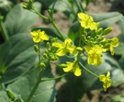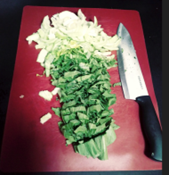By volunteer
 Bok choy or pak choi, like most familiar members in the family Brassicaceae (mustard family), is a cool weather vegetable commonly found in local supermarkets. Vegetables in the Brassicaceae family include cabbage, broccoli, collards, Brussels sprouts, and kale. Unlike cabbage, it does not form heads, instead forming broad leaf bases. Like all members in this family, the flowers have four petals and often grow as a basal rosette. Vegetables in this family are termed cruciferous vegetables because of the four petal “cross bearing” flower shape.
Bok choy or pak choi, like most familiar members in the family Brassicaceae (mustard family), is a cool weather vegetable commonly found in local supermarkets. Vegetables in the Brassicaceae family include cabbage, broccoli, collards, Brussels sprouts, and kale. Unlike cabbage, it does not form heads, instead forming broad leaf bases. Like all members in this family, the flowers have four petals and often grow as a basal rosette. Vegetables in this family are termed cruciferous vegetables because of the four petal “cross bearing” flower shape.
 Bok choy matures quickly. When planted indoors, it may go to seed when transplanted if the temperature is above 75 o F. Often people leave their fall bok choy crop in the garden. This produces homes for insects that overwinter and early spring flowers that provide food for pollinators, bees, and hummingbirds.
Bok choy matures quickly. When planted indoors, it may go to seed when transplanted if the temperature is above 75 o F. Often people leave their fall bok choy crop in the garden. This produces homes for insects that overwinter and early spring flowers that provide food for pollinators, bees, and hummingbirds.
If allowed to flower, its structure is interesting. Its floral formula is not difficult to understand.
K4 Co4 S2+4 P(2)
Interpretation– 4 sepals, 4 separate petals, 6 pollen bearing parts, and 2 united carpels with ovules. S2+4 indicates that two of the anthers have filaments longer than the other four.
Bok choy is among the easiest to grow from seed or “from scraps.” Click here for more information.
One large onion, garlic, one Bok Choy plant, stir-fried in oil for 2-3 minutes makes a nutritional meal that include selenium and potassium. You might like to add a butter fried crackers garnish.
-Tony Jevans and Cliff Keller, Edible Garden Volunteers


